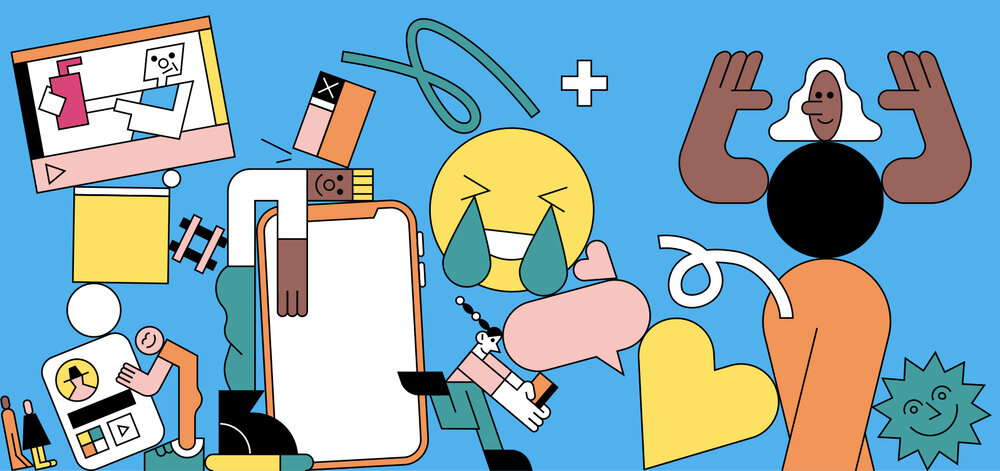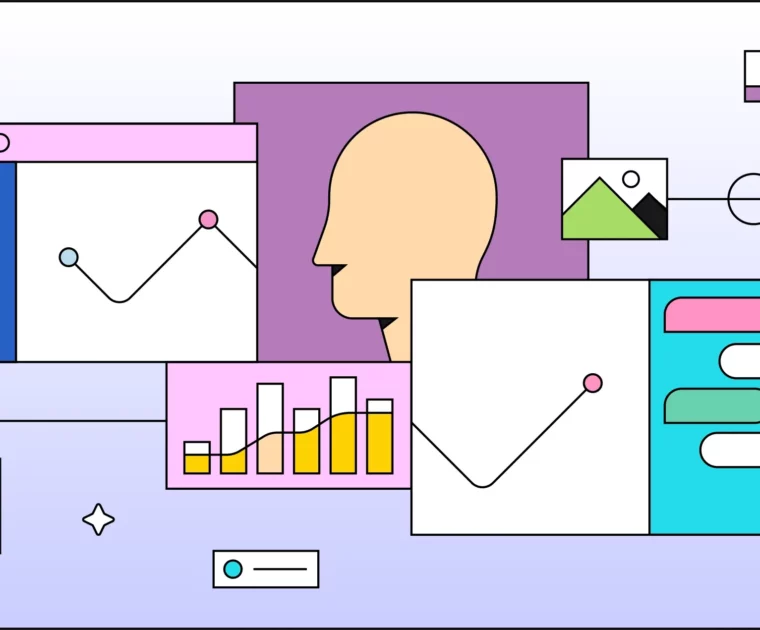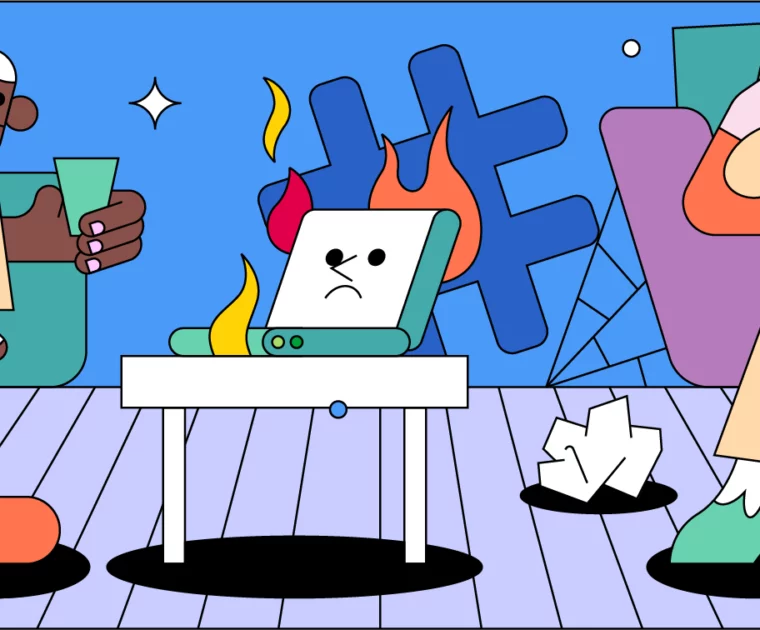In the 10+ years since social media influencer marketing became a thing, there have been tons of headlines questioning the future of the creator economy. Is it feasible for social media users to make hundreds, thousands, or hundreds of thousands of dollars from endorsing products online? Is the influencer market sustainable as an industry? Has it reached a plateau, or maybe even a decline? Does influencer marketing work? And if it does work, does it work on sophisticated consumers?
Well, we have some data that may help you answer that question for your team.
Brand Perspective: Influencer Marketing Delivers
The size of the influencer marketing industry has nearly 10x’d since 2016. Year over year, the industry expands as more traditional marketing campaigns are enhanced with digital marketing efforts that rely on content creators to reach consumers and essentially strengthen their brands across social media channels.
Since 2019, the percentage of brand marketers who say they are leveraging influencer marketing as part of their digital strategy has remained high. According to Influencer Marketing Hub, 93 percent of marketers say they’re currently running or plan to run influencer campaigns. Add to that this stat: 90 percent of marketers say influencer marketing is an effective strategy for achieving real marketing goals, and you’ll get a sense of why influencer marketing remains a mainstay for many brands. From their perspective, influencer marketing works.
Consumer Perspective: Influencers Are Trustworthy.
Influencers also play a key role in the purchasing decisions of a significant percentage of social media users. First of all, people like influencers. According to Klarna, 44 percent of Gen Zers and 30 percent of Millennials follow online celebrities. Eight in ten social media users have either made a purchase or considered purchasing something after interacting with influencer content. Half of consumers say they have gone into a store to see or buy products they discovered on their social feeds in the past three months, according to Salesforce.
Half?!!? That’s not nothing!
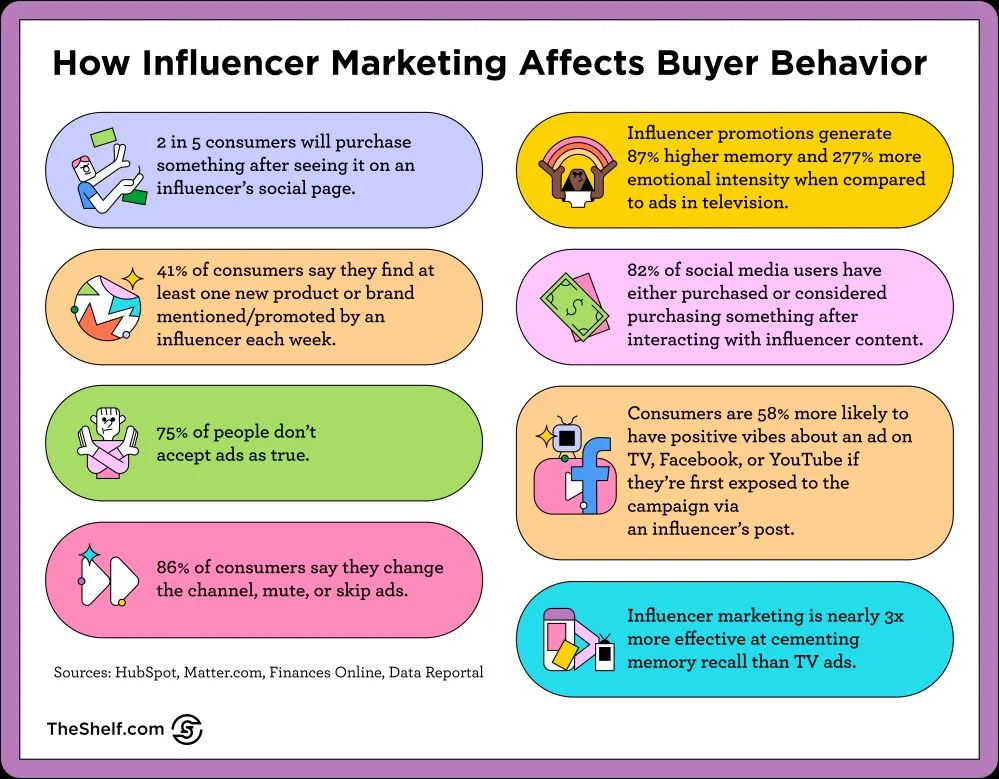
Influential content creators have the ability (and the relational equity) to drive their audiences to take steps toward a specific action. So… are we talking conversions here? 🤔
Not necessarily. What it means is that if an influencer has expressed positive sentiments about a brand or product, those positive sentiments about the product are often adopted by their followers as well. Influencers are seen as more trustworthy than brands, and influencer marketing is a tactic that allows brands to sort of ride the coattails of an influencer to [hopefully 🤞🏽] land in the good graces of the consumer.
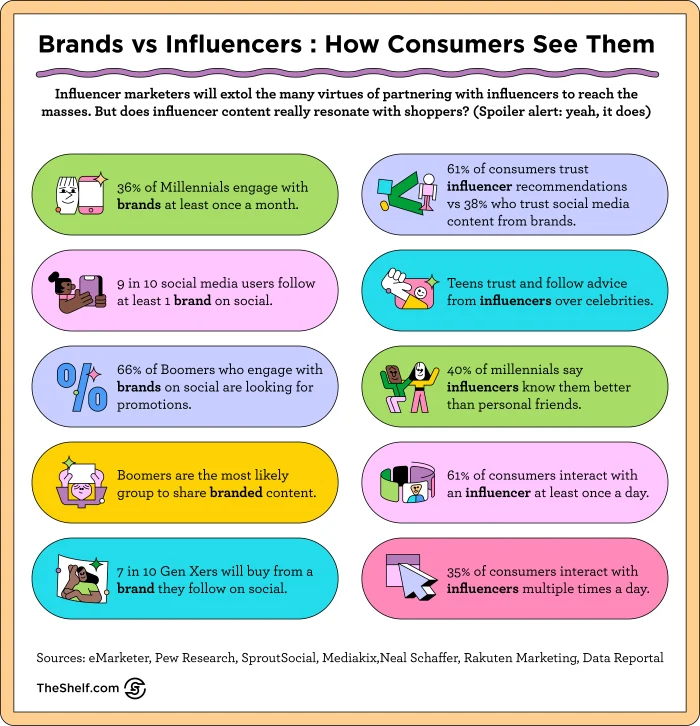
The Challenges with Influencer Marketing
We’ve already presented a pretty hefty number of influencer marketing stats that may already be helping to shape (or reshape) your ideas around influencer marketing. But let’s not ignore some pretty compelling challenges with influencer marketing.
Influencer-Generated Posts Are Just Ads
True. And people don’t love ads. In fact, most people don’t trust them. Globally, 4 in 10 internet users employ some sort of ad block technology on their devices. In the US, a little more than 1 in 4 consumers use ad blockers. Eighty-six percent of consumers find a way to not watch ads when they show up on a screen. And of the few who do watch ads, 75 percent of them don’t trust ads.
If people hate ads so much, why do they love influencers?
Short answer? It’s the presentation. For brands, the value of the sponsored content they get from influencers is all in the delivery, the timing, and the context (we keep trying to tell you about that context, man!). Influencer marketing is a type of social proof.
Influencer Marketing Is a Trend… And It’s in Flux.
While it’s true that influencer marketing is always changing, the industry isn’t in flux. And I think at this point we can retire the notion that influencer marketing is just a trend. Do you remember what the marketing landscape was like with COVID-19 first hit? Stores shut down. Most of us went home. Brands stopped spending money on ads and consumers were extremely critical of influencers who posted sponsored content, even knowing that many influencers make money to feed their families by pushing products.
But no one was in the mood for a pretty picture and a product post when people were dying and it was next to impossible to find basic cleaning supplies and toiletries. We were all bracing for the worst because we had no idea if we were experiencing it or if the worst was yet to come.
The pervasive thought was that a hit like COVID, which changed how people spent money and how they engaged online, could level the influencer marketing industry. Brands and marketers wondered if influencer marketing would recover from what seemed like it could be the death of sponsored content.
People wondered if influencer marketing was dead. Instead of influencer marketing dying on the vine, influencers essentially pivoted the industry, and not only has the industry more than doubled in size since 2020, but it’s also matured significantly.
That period of uncertainty, and horror, will go down in influencer marketing history as a pivotal moment for the industry. It’s not going anywhere, hoss.
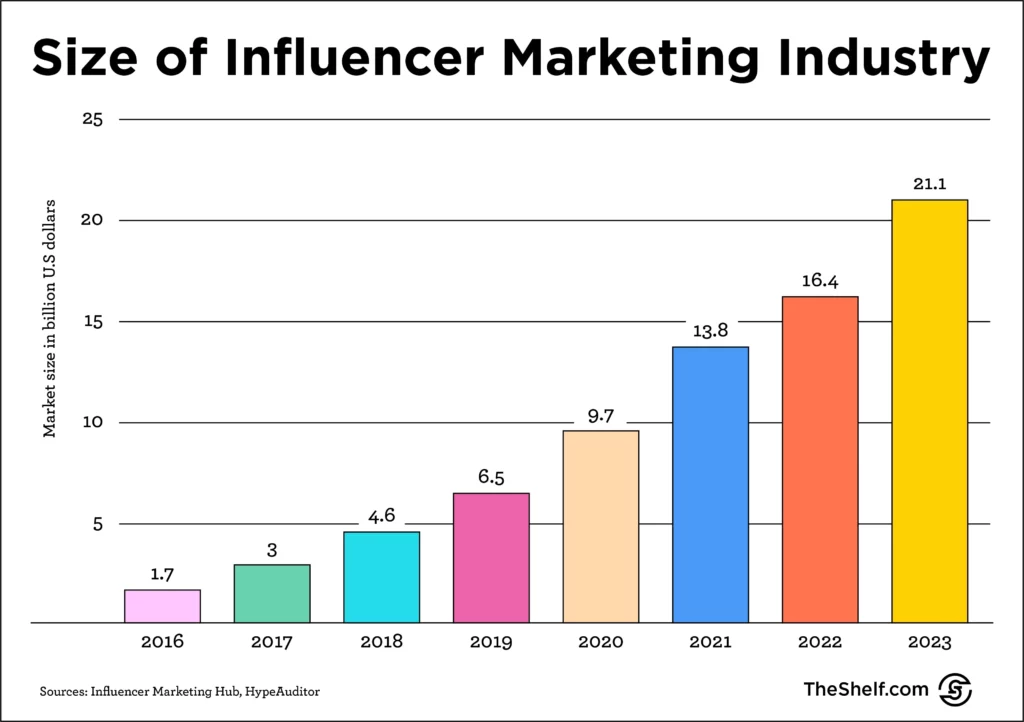
Fake Followers and Fake Engagement Make it Tough to Trust Those Pretty Pics
An AdAge article (gated content) reported that roughly 78 percent of the accounts following an influencer hired by Ritz-Carlton for a campaign were fake. Do you remember this headline? It was one of a slew of articles that came out a few years ago that questioned the legitimacy of brand-influencer partnerships as a viable marketing strategy.
Fast forward a few years, and we’re so used to hearing stuff like this that knowing an influencer has a bunch of fake followers doesn’t even shock us anymore. It actually seems kind of old school at this point — I mean who’s still buying fake followers? The looming threat of fake followers isn’t much of a threat when you have the tools to be able to spot that sort of thing. Seriously, we did a whole big post on how we use our influencer marketing platform to weed out influencer fraud.
Brand Safety Issues: The Bigger the Brand, the Bigger the Threat
This one lingers, especially as bigger brands that have been slow to go all in on influencer marketing make their way into the space. Brand safety issues are a real concern for many brands. There are several important steps we take to prioritize brand safety.
First, we have conversations with the client to help us really understand their goals AND to set expectations. That’s a big one. Next, we get really clear on the direction and creative concepting for the campaign — that usually loops in the product team and the marketing/brand team, as well as the client’s legal team. Third, we research the heck out of potential influencer partners to minimize the chances of partnering with someone who has red flags cropping up all over social media. We also make sure the influencers have a very clear understanding of the client’s expectations. Finally, we monitor campaigns in real-time, and our clients can do the same from their client dashboards.
Brand safety is a legitimate concern, and the only way to minimize threats to brand safety is through good, old-fashioned leg work — of the digital variety.
6 Reasons Influencer Marketing Works to Help You Reach Marketing Goals 🎯
Now let’s look at the reasons influencer marketing still works.
#1 Influencer Marketing Lets You Hyper-Target YOUR Audience
Unlike the early days of influencer marketing (like, 5 years ago), it’s not about having a gazillion followers; it’s about having the right followers. For instance, nano-influencers (social media influencers who have amassed between 1k to <10k followers on a single platform) may have a smaller following compared to mega-influencers, but their followers are the die-hard, super-engaged types. That means your message reaches the people who are genuinely interested and more likely to convert.
Influencers are like the cool kids who know everyone at the party. But here’s the kicker: they hang out with a crowd that’s super into the same stuff. Whether it’s tech gadgets, vegan recipes, or DIY home decor, influencers often have a niche audience. So, when they endorse your product or service, you’re not casting a wide net; you’re going straight to the folks who are already interested.
You’re also not going in blindfolded with your fingers crossed. Influencers are pretty savvy when it comes to knowing who’s following them. They often have access to insights that show the age, gender, location, and interests of their audience. That’s like having a treasure map for your marketing — you don’t have to guess.

#2 Influencers Know How to Build Authentic Connections
For influencers, trust and authenticity are non-negotiable; they’re also two major benefits of influencer marketing that drive positive consumer sentiment. You see, unlike the slick and polished ads we’ve grown accustomed to (and have learned to ignore), influencer recommendations have a down-to-earth, relatable vibe that just hits different. Here’s why:
Relatable Influencers = Relatable Recommendations:
Influencers aren’t your typical spokespeople. They’re everyday people who just happen to be exceptionally good at what they do. Whether it’s fashion, food, fitness, or whatever floats their boat, they’re passionate about it, and that passion shines through in their content. When they talk about a product or service, it’s like getting advice from a friend.
Authentic Reviews:
Most influencers won’t lie to their followers about the advantages and disadvantages of a particular product. They’re not brutal or slanderous; influencers are tactful and strategic. They’re not afraid to say when something doesn’t live up to the hype. That kind of honesty resonates with their followers. It’s like having a buddy who tells you if a movie is a must-see or a total flop.
Long-Term Relationships:
Many influencers build long-term relationships with their followers. They’re not just in it for the quick buck. They genuinely care about the people who support them. So, when they promote a product, it’s not just a one-off thing; it’s an ongoing conversation. That consistency builds trust over time.
Real-Life Demonstrations:
Influencers often show how a product fits into their daily lives. It’s not just a fancy photoshoot; it’s a peek behind the curtain of their existence. Seeing how a product is genuinely used in their world makes it feel more real and relatable.
Peer Recommendations:
People trust their peers more than ads. When an influencer says, “Hey, I tried this and loved it,” it carries weight because it’s coming from someone who seems like your equal, not a salesperson trying to hit their quota.
Built-In Filters:
Followers choose to follow influencers who align with their interests and values. So, when an influencer promotes something, it’s already pre-filtered for relevance. That means you’re more likely to reach an audience that’s genuinely interested in your product or service.
In a nutshell, influencer marketing is like the digital version of word-of-mouth recommendations. It’s genuine, relatable, and trustworthy, making it a powerful tool to connect with your target audience on a deeper level. So, when it comes to building trust and authenticity in marketing, influencers are the real deal.

#3 Influencers Create Diverse Content That Trumps a Semi-Annual Product Shoot
This one is perhaps one of the most valuable benefits of effective influencer marketing and simultaneously the most underutilized. Influencer-generated content is tailor-made to resonate with a particular group of people. It’s aspirational without being grandiose. Relevant without being hammy. It’s curated without being a highlight reel. Influencers walk a fine line between the current situation and that better tomorrow everyone’s always chasing after. And that’s a quality that many brands can’t capture because you kinda have to know someone’s origin story to forge that kind of connection.
Brands have the opportunity to repurpose influencer-created content (UGC) at multiple touchpoints along the path to purchase. We’ve seen clients reuse influencer content on their websites, on their product pages, in print ads, and even as murals in their physical locations. And if you build diversity into your influencer selection process, you automatically get a catalog of assets that are diverse in their artistry, messaging, in the way the idea is captured, and even in how it’s distributed. A single campaign may deliver content that includes:
- Real-world product demonstration (a show-and-tell for the product)
- Unboxing videos (see them open the box and use the product)
- Review of the product and the results (after using it for several days, weeks, or months)
- Day-in-the-life content that contextually embeds your product
- Tips for how to use the product (makeup tutorials, styling/fashion tips, etc.)
- Taking glam shots wearing the product (bikini on the beach, night out on the town wearing heels, posing with a purse in front of the Trevi Fountain)
- Short-form videos that are creative and highly entertaining
And this makes for great repurposed.

#4 Influencer Content Outperforms Branded Content
When measured side-by-side, influencer content consistently drums up more engagement than branded content. Using the help of multiple influencers, you can get better content out at a quicker pace than you would on your own, grab more attention, and generate more instances of engagement than you would with branded content.
That alone is priceless. Especially with users consuming 11.4 pieces of content across nine different channels before finally making that decision to purchase.

#5 You Don’t Need Mega-Influencers to Win
This is good news, right? Back in the day, brands really wanted to partner with the biggest influencers they could afford without consideration for the level of actual influence content creators may have wielded in a particular vertical.
At this point, I think most brands have figured out that partnering with a bigger influencer doesn’t guarantee interest or clicks, it only promises that your product will be seen by more people, and they may not even be the right people.
Targeting is more important than impressions if your goal is to drive people into your funnel.

#6 You Build an Omnichannel Echo-Chamber
First, let’s clarify what omnichannel marketing is all about. It’s not just about being present on multiple channels; it’s about providing a unified, consistent brand experience across those channels, especially the social media channels most likely to drive ROI for your influencer campaign. Whether your customers interact with your brand via social media, your website, email, or in-store, they should encounter a consistent message, look, and feel.
Influencers have a unique ability to connect with audiences across different platforms. They’re masters of creating engaging and relatable content, making them a perfect fit for omnichannel marketing. Start by identifying influencers whose values align with your brand. Look for those who have a presence on the platforms relevant to your audience. Your chosen influencers should have a strong following and credibility in those spaces.
Work with influencers to develop content that can be adapted for various channels. For example, a video review on YouTube can be repurposed as a series of short clips for Instagram Stories, while the main takeaways can be turned into blog posts or email newsletters.
One thing the content marketing team here at The Shelf has really tried to do is lean into interactive content. Influencers often engage with their followers through polls, Q&A sessions, or challenges. Encourage them to create interactive content that can be seamlessly integrated into your omnichannel strategy. This not only boosts engagement but also encourages cross-channel participation.
Incorporating influencer content into your omnichannel marketing strategy can elevate your brand’s presence and effectiveness. By strategically leveraging influencers who resonate with your target audience and maintaining a consistent message across channels, you can create a seamless and memorable brand experience that keeps customers engaged and loyal. So, go ahead and tap into the power of influencer marketing to master the art of omnichannel success!
Influencer Marketing Is a Mainstay of Digital Strategies
The effectiveness of influencer marketing is undeniable. It thrives on trust, authenticity, and targeted reach, creating a powerful connection between brands and their audiences. With influencers as trusted advocates, the content they create not only engages but also converts, making influencer marketing a must-have strategy in the modern marketing playbook.
As businesses continue to harness the unique qualities of influencer marketing, they find themselves on the path to building stronger brand connections and achieving tangible results. So, whether you’re a startup or a seasoned brand, consider embracing influencer marketing — it’s a proven recipe for success in today’s digital age.


